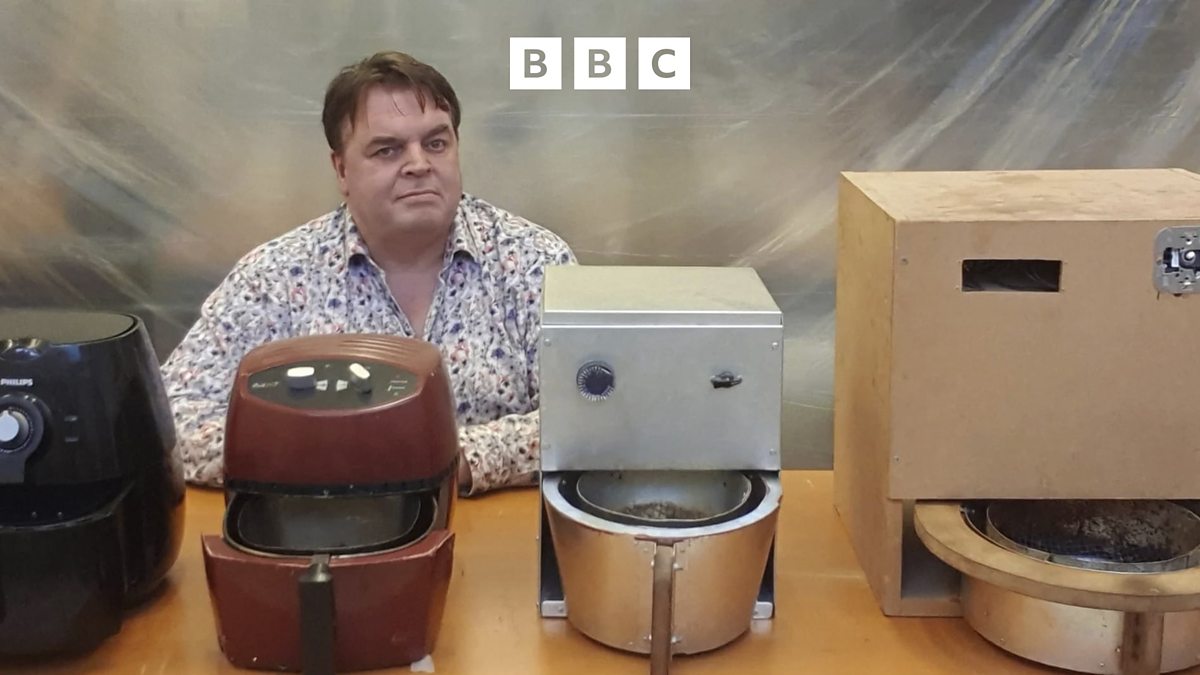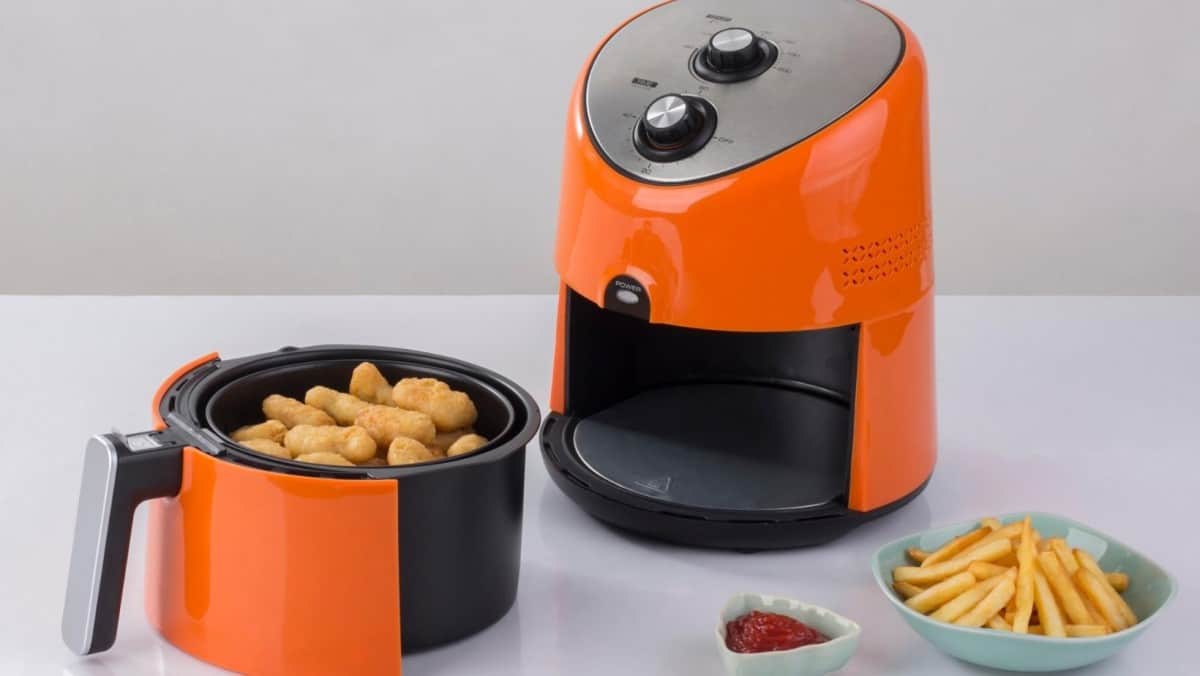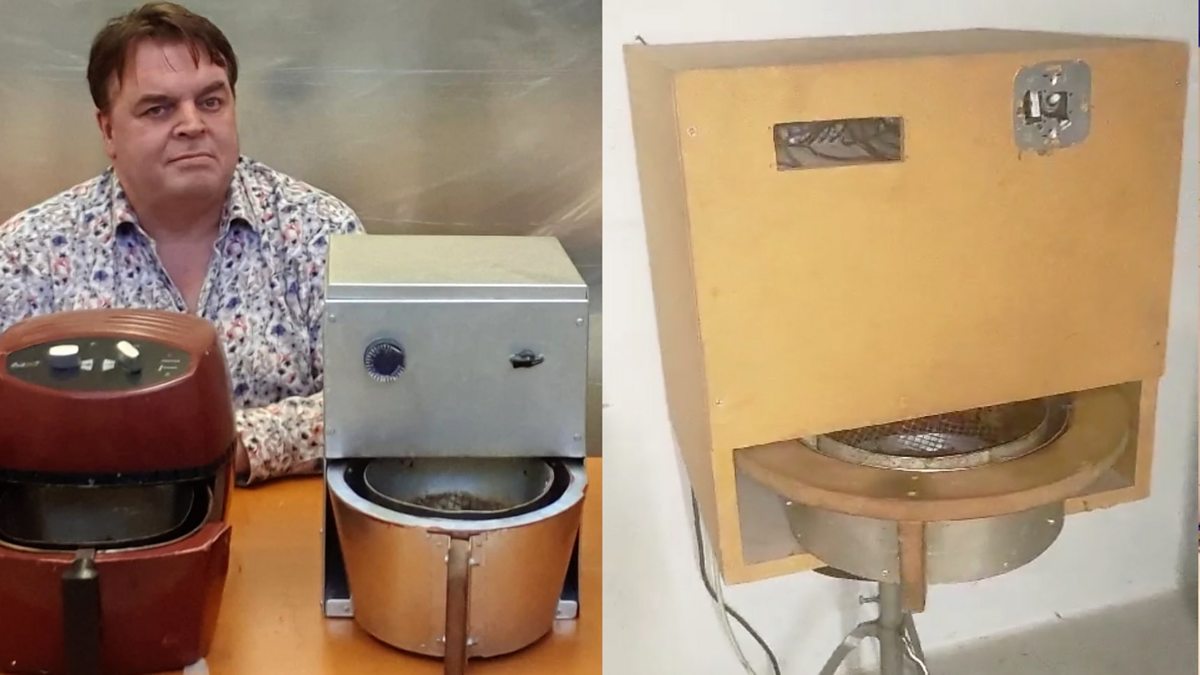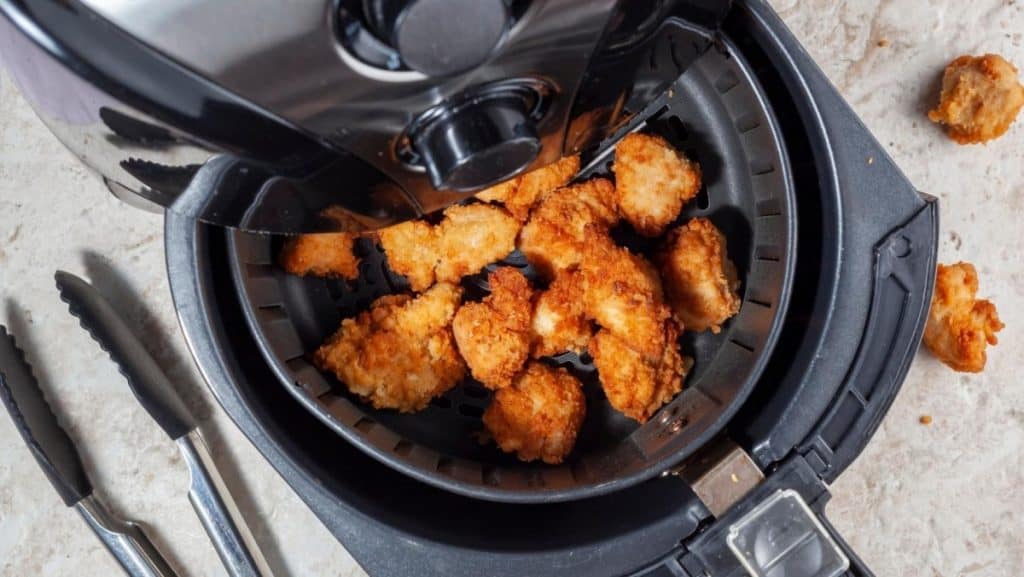As an Amazon Associate KitchenwareSets.com earns from qualifying purchases.
Air Fryer Invention: Who Invented It, Key Technology, and Its Evolution
Who invented the air fryer? This innovative kitchen gadget has transformed the way we cook, but many are still unaware of its fascinating origins.
As health-conscious consumers seek out alternatives to traditional frying methods, understanding the air fryer’s invention becomes crucial for those wanting to make informed culinary choices.
The modern air fryer was invented by Fred van der Weij in 2006, utilizing his patented rapid air technology to offer a healthier cooking option that mimics the results of deep frying.
Curious about how this revolutionary appliance came to be? In this article, we’ll explore Fred van der Weij’s journey, the evolution of air-frying technology, and its historical roots, including key figures like William Maxson. You’ll also learn about how air fryers work, their rise in popularity, and what the future holds for this beloved kitchen appliance.
Key Facts:
1. Fred van der Weij invented the modern air fryer in 2006.
2. The air fryer uses rapid air technology to cook food with up to 80% less oil.
3. William L. Maxson developed an early prototype called the Maxson Whirlwind Oven in the 1940s.
4. Philips launched the first commercial air fryer in 2010.
5. Air fryers have gained immense popularity due to their health benefits and convenience.
The Birth of the Modern Air Fryer
The modern air fryer is a culinary marvel that has revolutionized home cooking. Its inception is a tale of innovation, perseverance, and a dash of serendipity. Let’s dive into the fascinating story behind this kitchen game-changer.
Fred van der Weij: The Mastermind Behind the Air Fryer
Fred van der Weij, the mastermind behind the air fryer, is a Dutch inventor whose passion for creating healthier cooking alternatives led to a breakthrough in kitchen technology. His journey began in 2005 when he set out to develop a device that could produce crispy, delicious fried foods with significantly less oil.
Van der Weij’s eureka moment came when he realized that circulating hot air at high speeds could achieve the same crispy texture as deep frying. This insight led to the development of his patented rapid air technology, which forms the core of modern air fryers.

A sleek modern air fryer ready for cooking – Source
The Wooden Prototype: A Humble Beginning
Van der Weij’s first prototype was far from the sleek appliances we see today. In fact, it resembled a wooden dog kennel more than a kitchen gadget! This crude model, however, successfully demonstrated the principle of air frying and set the stage for further development.
“I wanted to create a healthier way to enjoy fried foods without sacrificing taste or texture,” – Fred van der Weij
From Concept to Market: The Philips Partnership
While van der Weij had the brilliant idea and a working prototype, bringing the air fryer to market required the resources and reach of a major company. Enter Philips, the Dutch electronics giant.
Recognizing the potential of van der Weij’s invention, Philips partnered with the inventor to refine the design and prepare it for mass production. This collaboration led to the launch of the Philips Airfryer in 2010, marking the air fryer’s official entry into the consumer market.
Key Features of the First Commercial Air Fryer
- Rapid Air Technology: The patented system that circulates hot air to cook food.
- Adjustable Temperature Control: Allowing users to cook various foods at optimal temperatures.
- Timer Function: Ensuring precise cooking times and preventing overcooking.
- Dishwasher-Safe Parts: Making cleanup a breeze for busy households.
The Philips Airfryer quickly gained traction, appealing to health-conscious consumers and busy families alike. Its ability to produce crispy, “fried” foods with up to 80% less fat than traditional frying methods was a game-changer in the culinary world.
Historical Roots: The Air Fryer’s Predecessor
While Fred van der Weij is credited with inventing the modern air fryer, the concept of cooking food with circulating hot air has deeper historical roots. To truly appreciate the air fryer’s evolution, we need to step back in time and explore its fascinating predecessor.
William L. Maxson and the Whirlwind Oven
Long before van der Weij’s breakthrough, an American inventor named William L. Maxson was pioneering similar technology. In the 1940s, Maxson developed the Maxson Whirlwind Oven, a device that used circulating hot air to cook frozen meals.
The Military Connection
Maxson’s invention was primarily designed for use in military aircraft during World War II. The U.S. Navy saw great potential in the Whirlwind Oven as a means to provide hot, nutritious meals to troops during long flights. This military application laid the groundwork for future developments in air frying technology.

A modern air fryer, descendant of Maxson’s Whirlwind Oven – Source
Key Differences: Maxson’s Oven vs. Modern Air Fryers
While Maxson’s Whirlwind Oven and modern air fryers share the basic principle of cooking with circulating hot air, there are several key differences:
- Size and Portability: The Whirlwind Oven was much larger and designed for industrial use, while modern air fryers are compact and suitable for home kitchens.
- Cooking Purpose: Maxson’s invention was primarily for reheating frozen meals, whereas air fryers are versatile devices capable of cooking a wide range of fresh and frozen foods.
-
Technology: Modern air fryers use more advanced rapid air technology, allowing for better heat distribution and more consistent cooking results.
-
Accessibility: The Whirlwind Oven never reached the consumer market, while air fryers have become a staple in many households worldwide.
Despite these differences, Maxson’s work undoubtedly paved the way for future innovations in air frying technology. His vision of using hot air circulation for cooking was ahead of its time and laid the foundation for the air fryers we know and love today.
How Does an Air Fryer Work?
How does an air fryer work? At its core, an air fryer operates on a simple yet ingenious principle: rapid air circulation. This technology allows it to cook food quickly and evenly, producing crispy exteriors and moist interiors without the need for excessive oil. Let’s break down the mechanics behind this culinary marvel.
The Magic of Rapid Air Technology
Rapid air technology, the heart of every air fryer, is what sets these appliances apart from conventional ovens. Here’s how it works:
- Heat Generation: A heating element, typically located at the top of the air fryer, produces heat.
-
Air Circulation: A powerful fan circulates this hot air around the cooking chamber at high speeds.
-
Maillard Reaction: The rapid air circulation creates a Maillard reaction on the food’s surface, resulting in that desirable crispy texture and golden-brown color.
-
Even Cooking: The constant flow of hot air ensures that food is cooked evenly from all sides.
This process allows the air fryer to mimic the results of deep frying while using significantly less oil. In fact, most recipes require just a tablespoon of oil or even no oil at all!

Close-up of an air fryer’s control panel – Source
Key Components of an Air Fryer
To better understand how an air fryer functions, let’s look at its main components:
- Heating Element: Generates the heat necessary for cooking.
- Fan: Circulates hot air throughout the cooking chamber.
- Cooking Chamber: Where the food is placed for cooking.
- Basket or Tray: Holds the food and allows hot air to circulate around it.
- Control Panel: Allows users to set temperature, cooking time, and choose preset functions.
These components work in harmony to create the perfect cooking environment, resulting in crispy, delicious food with minimal oil usage.
Air Fryer vs. Convection Oven: What’s the Difference?
While air fryers and convection ovens both use circulating hot air to cook food, there are some key differences:
| Feature | Air Fryer | Convection Oven |
|---|---|---|
| Size | Compact, countertop appliance | Larger, often built-in |
| Cooking Speed | Faster due to smaller size and more concentrated heat | Slower, but can cook larger quantities |
| Air Circulation | More rapid and concentrated | Less intense |
| Oil Usage | Minimal to none | Usually requires more oil |
| Versatility | Primarily for “frying” and roasting | Can bake, roast, and perform other functions |
The air fryer’s compact size and intense air circulation make it particularly effective at creating crispy exteriors, making it ideal for foods traditionally prepared by deep frying.
The Rise of Air Fryers in Modern Kitchens
The rise of air fryers in modern kitchens has been nothing short of phenomenal. These compact appliances have swiftly transitioned from novelty gadgets to essential kitchen tools, revolutionizing the way we approach cooking. Let’s explore the factors behind their surging popularity and the impact they’ve had on home cooking.
Health-Conscious Cooking: A Driving Force
One of the primary reasons for the air fryer’s meteoric rise is its alignment with health-conscious cooking trends. As more people become aware of the health risks associated with excessive oil consumption, air fryers offer a compelling alternative:
- Reduced Oil Usage: Air fryers can produce crispy, “fried” foods using up to 80% less oil than traditional deep frying methods.
- Lower Calorie Content: By significantly reducing oil usage, air-fried foods tend to be lower in calories and fat.
- Retention of Nutrients: The quick cooking process helps retain more nutrients compared to some other cooking methods.
These health benefits have made air fryers particularly appealing to those looking to maintain a balanced diet without sacrificing the taste and texture of their favorite fried foods.

An air fryer surrounded by fresh ingredients – Source
Convenience and Versatility: The Perfect Kitchen Companion
Beyond health benefits, air fryers have gained popularity due to their convenience and versatility:
- Quick Cooking Times: Air fryers preheat and cook faster than conventional ovens, making them ideal for busy households.
- Easy to Use: With simple controls and often pre-set cooking programs, air fryers are user-friendly even for novice cooks.
- Versatile Cooking Options: While known for “frying,” air fryers can also roast, bake, and even reheat leftovers.
- Energy Efficient: Their compact size and quick cooking times make air fryers more energy-efficient than larger appliances.
- Easy Cleanup: Many air fryer components are dishwasher-safe, simplifying the post-cooking cleanup process.
These features have made air fryers a go-to appliance for everything from quick weeknight dinners to creative culinary experiments.
The Role of Social Media and Online Communities
The popularity of air fryers has been significantly boosted by social media and online communities. Platforms like Instagram, TikTok, and Facebook have become hubs for air fryer enthusiasts to share recipes, tips, and mouthwatering photos of their creations.
“The air fryer community on social media has exploded, with millions of posts showcasing innovative recipes and cooking tipss.”
This online buzz has not only helped spread awareness about air fryers but has also created a supportive community for users to exchange ideas and inspiration. Popular hashtags like #airfryerrecipes and #airfryermeals have millions of posts, demonstrating the appliance’s cultural impact.
Impact on Cooking Habits and Meal Preparation
The widespread adoption of air fryers has noticeably influenced cooking habits and meal preparation:
- Increased Home Cooking: The ease of use has encouraged more people to cook at home rather than relying on takeout.
- Experimentation with Recipes: Users are adapting traditional recipes for air fryer use and creating entirely new dishes.
- Healthier Alternatives: Many are using air fryers to create healthier versions of traditionally fried foods.
- Portion Control: The basket size of most air fryers naturally encourages cooking in smaller portions.
As air fryers continue to evolve and improve, their impact on modern kitchens and cooking habits is likely to grow even further.
Future of Air Fryers: What’s Next?
The future of air fryers looks bright and promising, with ongoing innovations set to enhance their functionality and appeal. As these appliances continue to evolve, we can expect to see advancements that will further revolutionize home cooking. Let’s explore some exciting developments on the horizon.
Smart Technology Integration
One of the most significant trends in air fryer evolution is the integration of smart technology:
- Wi-Fi Connectivity: Future air fryers may connect to home Wi-Fi networks, allowing users to control and monitor cooking from their smartphones.
-
Voice Control: Integration with smart home assistants like Alexa or Google Home could enable voice-activated cooking commands.
-
Recipe Apps: Dedicated apps might offer curated recipes, automatically setting the optimal temperature and cooking time for each dish.
-
Cooking Notifications: Smart air fryers could send notifications to your device when preheating is complete or when food is ready.
These smart features aim to make cooking even more convenient and foolproof, catering to tech-savvy consumers who value connectivity in their kitchen appliances.
Enhanced Cooking Technology
Advancements in cooking technology are set to make air fryers even more versatile and efficient:
- Improved Heating Elements: More powerful and efficient heating elements could reduce cooking times and energy consumption.
- Multi-Zone Cooking: Some models might feature multiple cooking zones, allowing different foods to be cooked simultaneously at varying temperatures.
- Precision Temperature Control: More accurate temperature sensors and controls could lead to even better cooking results.
- 3D Heating Technology: Advanced models might incorporate heating elements on all sides for more even cooking.
These technological improvements aim to expand the range of dishes that can be prepared in an air fryer, potentially making it the go-to appliance for a wider variety of cooking tasks.

A modern air fryer with freshly cooked food – Source
Sustainability and Environmental Impact
As environmental concerns become increasingly important to consumers, future air fryers are likely to focus on sustainability:
- Energy Efficiency: Newer models may incorporate even more energy-efficient technologies, reducing power consumption.
-
Eco-Friendly Materials: Manufacturers might use more sustainable materials in air fryer construction, such as recycled plastics or biodegradable components.
-
Longevity and Repairability: Future designs could focus on durability and ease of repair, reducing electronic waste.
-
Water-Saving Features: Some models might incorporate features to clean the cooking chamber with minimal water usage.
These eco-friendly innovations could make air fryers an even more attractive option for environmentally conscious consumers.
Expanded Functionality
The future may see air fryers evolving into true multi-functional cooking devices:
- Combination Appliances: We might see more air fryer-microwave or air fryer-toaster oven combinations, saving counter space and offering greater versatility.
- Sous Vide Capability: Some high-end models might incorporate sous vide cooking features, expanding their culinary repertoire.
- Dehydration Function: Air fryers could incorporate dehydration settings, allowing users to make dried fruits, jerky, and other preserved foods.
- Pressure Cooking: Integration of pressure cooking technology could further expand the range of dishes that can be prepared.
These expanded functions could potentially position air fryers as all-in-one cooking solutions, further cementing their place in modern kitchens.
Personalized Cooking Experiences
Future air fryers might offer more personalized cooking experiences:
- AI-Powered Recommendations: Machine learning algorithms could analyze user preferences and suggest recipes or cooking adjustments.
-
Customizable Presets: Users might be able to create and save their own cooking presets for favorite dishes.
-
Health Tracking Integration: Air fryers could potentially sync with health apps to provide nutritional information for cooked meals.
-
Adaptive Cooking: Advanced sensors might adjust cooking parameters in real-time based on the food’s moisture content and size.
These personalized features aim to make air fryers even more user-friendly and tailored to individual cooking styles and dietary needs.
Challenges and Considerations
While the future of air fryers looks promising, there are some challenges to consider:
- Cost: Advanced features may increase the price point, potentially making high-end models less accessible.
- Complexity: As functionality expands, manufacturers will need to ensure that air fryers remain user-friendly and intuitive.
- Size Constraints: Balancing increased functionality with compact design could be a challenge for future models.
- Market Saturation: As the air fryer market becomes more crowded, brands will need to innovate to stand out.
Despite these challenges, the ongoing evolution of air fryers suggests a future where these appliances become even more integral to our cooking routines, offering enhanced convenience, health benefits, and culinary possibilities.
FAQs About Who Invented the Air Fryer
Q: Who invented the modern air fryer?
A: The modern air fryer was invented by Fred van der Weij, a Dutch engineer, in 2006. Van der Weij developed the patented rapid air technology that forms the core of today’s air fryers.
Q: What was William L. Maxson’s contribution to air fryer technology?
A: William L. Maxson developed the Maxson Whirlwind Oven in the 1940s. While not an air fryer in the modern sense, this device used circulating hot air to cook frozen meals, laying the groundwork for future air frying technology.
Q: How does an air fryer work differently from traditional fryers?
A: Air fryers use rapid air technology to circulate hot air around the food, cooking it evenly and creating a crispy exterior. Traditional fryers submerge food in hot oil. Air fryers typically use 70-80% less oil than deep fryers, making them a healthier alternative.
Q: Are air fryers healthier than traditional frying methods?
A: Yes, air fryers are generally considered healthier than traditional deep frying methods. They use significantly less oil, resulting in lower fat and calorie content in the cooked food. However, the healthiness of the final dish also depends on the ingredients used.
Q: What advancements can we expect from future air fryer models?
A: Future air fryers are likely to incorporate smart technology, improved cooking functions, and sustainability features. We may see Wi-Fi connectivity, voice control, multi-zone cooking, and integration with other cooking methods like sous vide or pressure cooking. Additionally, there may be a focus on energy efficiency and eco-friendly materials.
Summary
The invention of the air fryer marks a significant milestone in culinary innovation, revolutionizing how we approach healthier cooking. Fred van der Weij’s creation in 2006, building upon earlier concepts like William Maxson’s Whirlwind Oven, has transformed from a novel gadget into an essential kitchen appliance.
The air fryer’s rapid rise to popularity can be attributed to its ability to produce crispy, delicious food with minimal oil, appealing to health-conscious consumers. Its convenience, versatility, and the supportive online community have further cemented its place in modern kitchens.
Looking ahead, the future of air fryers promises even more exciting developments. From smart technology integration and enhanced cooking capabilities to a focus on sustainability, these appliances are set to become even more integral to our cooking routines.
As we reflect on the question “Who invented the air fryer?”, we’re reminded of the power of innovation to shape our daily lives. The air fryer’s journey from a wooden prototype to a smart, multi-functional appliance illustrates how a simple idea can evolve to meet changing consumer needs and preferences.
What’s your experience with air fryers? Have they changed the way you cook? As these appliances continue to evolve, it’s exciting to imagine how they might further transform our culinary landscapes in the years to come.
